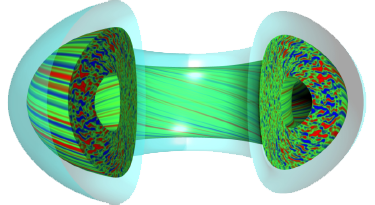Speaker
Description
Recently, a linear disruption predictor was installed in the JET real-time network for mitigation purposes. From a mathematical point of view, the predictor is based on computing centroids of disruptive examples and non-disruptive examples in a two-dimensional space. This is the reason of calling it centroid method (CM). It uses a single signal: the mode lock normalised to the plasma current. The predictor is not based on thresholds to trigger alarms but on the differences of amplitudes between consecutive samples. The article analyses its results for the range of discharges 94152 – 97137 (June 2019 – March 2020), in particular, discharges of both baseline scenario and hybrid scenario. The article presents a comparison between the CM predictor and several different disruption detection systems on board PETRA in the JET real time network. PETRA reads in real time data to produce different types of ‘events’, which are then fed into the Real Time Protection System (RTPS) for JET during a discharge. The comparison takes into account the conditions to trigger the disruption mitigation valve (DMV): plasma current ≥ 2 MA and plasma total energy ≥ 5 MJ. For baseline scenario, the CM predictor detected a total of 83.87% disruptions prior to the normalized mode lock (NRMLOCA) event detector and detections were made 61.8 ms before NRMLOCA detector on average. In case of normalized combined loop voltage (NRMCMBLV) event detector, the CM predictor detected 87% disruptions prior to NRMCMBLV detector with an average 61.5 ms early detection. The event detector based on short range time derivative of plasma current (SHRTDIDT) was bettered by the CM predictor for 90% of disruptions with an average 64 ms early detection. The CM predictor outperformed long range time derivative of plasma current (LONGDIDT) based event detector for 94% of detected disruptions and did so with an average early warning time of 60 ms. In case of hybrid scenario discharges, the trend is followed for all the event detectors attached to the disruption mitigation alarms 1 and 2, although the average time of early detection for CM predictor reduces to tens of ms. Against NRMLOCA detector, CM predictor detected 80% of disruptions beforehand with an average improvement of detection time by 9 ms. The NRMCMBLV detector was bettered by CM predictor for 70% of detected disruptions and the average gain on detection time was deduced to be 118 ms. The LONGDIDT and SHRTDIDT detectors were also found lagging behind the CM predictor by an average 9.5 ms for 80% of detected disruptions.
| Country or International Organisation | Spain |
|---|---|
| Affiliation | LABORATORIO NACIONAL DE FUSION, CIEMAT |

